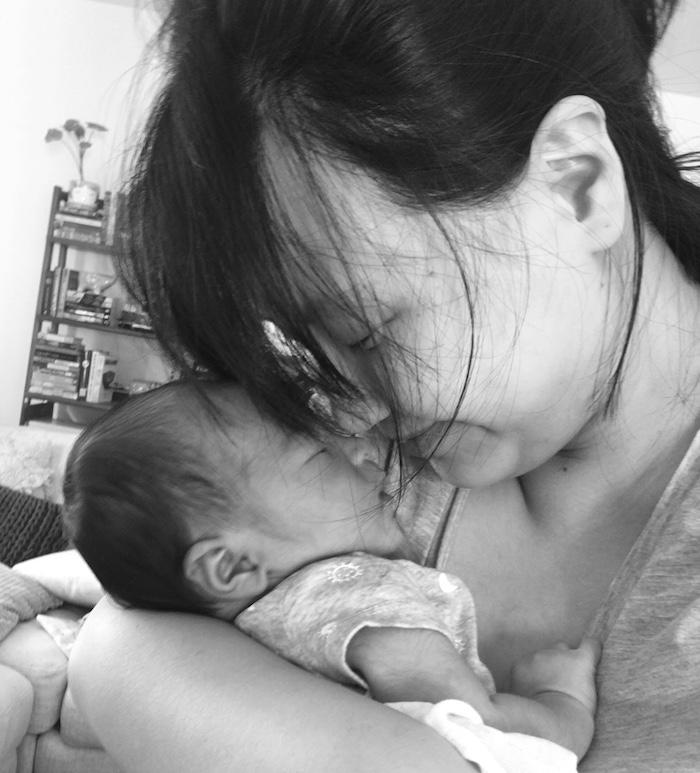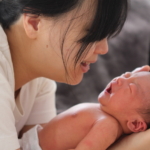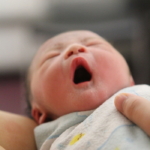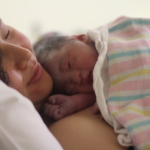AUTHOR'S NOTE: This is the bonus post of the original three-part series of how little bao came into the world, and the days following his arrival. (Read the first, second, and third part on these respective links.) Just a warning: It's a lengthy one. The last word count of the total story is almost 12,000 words, but I'm hopeful in sharing mine, others can learn from it, or realise that they are not alone.
Tips, Tricks, and The Things That Work (For Me)
Along my journey, I have learned a lot about taking care of a newborn (well, for the first six weeks anyway), and I want to list this down as a reminder for the future—if and when I have a second child. Hopefully by doing so, you’ll learn a trick or two as well.
So here are the things that work, and those that don’t, and the things that are worth their bucks.
Postpartum
- Ninja Mama Peri bottle is a luxury item, but one that I would advocate to vaginal birthing mums everywhere. If you have stitches, it stings down there to pee for the first few days. Just make yourself comfortable and spray some water while going to the toilet. Of course, any cheap squirt bottle also works, but I really like the angle of this one. Recovery will be easier.
- Depends disposable underwear is so, so good. You don’t have to buy a high waisted underwear—just grab one or two packs of this. It provides support even for c-section mums (as advocated by my sister), and it’s disposable so there will one less thing you need to worry about if you’re thinking of washing your blood-soaked undies when you get home from the hospital. If you’re like me and like to stretch things further, I even put on a pad on top of this underwear so that I only change the underwear minimally. Talk about being cost effective.
- If you’re birthing vaginally, Medichill ice packs are lifesavers. Using this religiously for the first few days reduced my swelling so well, to the point when I got home, I was able to move like almost normal, barring the occasional pain and soreness around the stitches. And speaking about pain…
- Take all those painkillers your doctor or midwives offer you. Don’t try to be a warrior; there’s no prize in the end, only more pain while dealing with a crying baby. Throughout my hospital stay I really felt minimal pain—apart from the soreness when sitting up straight to breastfeed, or trying to stand up from sitting position. By the time I was discharged, I had zero pain, which came back a few hours later at home, and I had Panadol/ibuprofen occasionally at home until two weeks postpartum.
- Say yes to stool softener when offered by the midwives. Or if they don’t offer it, ask for one. It would make the first bowel movement experience much less daunting.
- On that note, you’ll probably get haemorrhoid. (One of the midwives described it as the ‘joy of pushing’.) They could give you cream to soothe it.
- One last thing on this topic: Get the IKEA children’s stool (or any other stool) to prop up your feet while you’re doing the deed. The hospital’s physio told me that this is the correct-slash-recommended way to do number two, and that it puts less strain and pressure on your bowel after it has been beaten and bruised.
- Go to the toilet religiously, every two or three hours, even when you don’t feel the urge to pee. Thing is, everything is somewhat messed up down there—after all, you’ve birthed a baby. My obs told me it would take a while, up to six weeks, for all functions to return to normal, so for now just stick to the routine. It really hurts to empty your bladder if you haven’t gone in a while, as you really don’t feel the urge. (I mean, every sensation sort of blurs down there, so who knows which urge is which?)
- I had the shivers in the morning for the first two weeks, usually at around 4 or 5 am, to the point that I had to turn on the heater in the morning to feed my son (it’s currently autumn here in Melbourne). Apparently this is common, normal, and hormonal (says my sister—she had it too), and will probably still continue for a bit.
- You would bleed for the six weeks (well, I did anyway). Stock up on pads (enough for the first three) and panty liners (enough for the second three).
- Not from me (I haven’t felt the benefit yet), but from my colleague who had gone through it all: As soon as you can move, start your pelvic floor exercises. I had a physio who visited me while still in hospital and she showed me a few exercises to follow. Honestly, I haven’t done them diligently at all, so I might have to pick up the slack. (I mean, doing exercise while you have a newborn might be the last thing on your mind. But my colleague reassured me that the future me would be grateful for it.)
Feeding
- Breastfeeding is hard. Really. It’s been six weeks and I still face new challenges. I thought by this stage I thought I’d have gotten everything figured out! I’ve gone from cracked and sore nipples, to nipple shields, to blocked ducts, to weaning bub from nipple shields, and now back to blocked ducts and sore/sensitive nipples because my nipples are finally used ‘properly’. I’m learning to do the correct latch again because I’ve been so pampered with the shields. Just remember that it gets better.
- The app “Baby Tracker” is useful. It lets you keep track of nappies, when did you last feed your baby, how long are the feeds, etc.
- That being said, sometimes recording everything will cause anxiety (like: “I’ve got one-and-a-half-hour to sleep max so I need to fall asleep like, now,”), so after the first few weeks, only record if you have to. Do what works for you.
- I find this page is a good starting point when learning about breastfeeding.
- Most of the advices given to me (that are useful) by the midwives and lactation consultant can be watched through this video. One of the midwives told me about the reset position and recommended me doing it while doing skin-to-skin, which was reiterated by the lactation consultant. Another told me about the nipple-to-nose position, as well as tucking in his bum using my elbow to have a better hold. I haven’t used the thumb thing, so I can’t really comment on that.
- If you’re struggling with breastfeeding, see a lactation consultant—the earlier the better. Everyone will almost always have an opinion on how to breastfeed, and even the midwives can get it really wrong. A lactation consultant can deduce the problem, as they are the experts in the field. Get it fixed, and get it fixed quick.
- On that note, I hope you already know from my birth novel but breastfeeding should not hurt, apart from the initial latch. If it does, don’t persevere through the pain—get help and see a lactation consultant.
- That being said, I’m very lucky to have found my ‘problem’ early (after my milk came anyway), and that it was something that has an easy fix. Plus, my baby was quite content to switch between breast, nipple shield, syringes, Pigeon bottles, and Medela single-use bottles during those first few days. Do what you have to do, and what works for both of you—be it mix feeding, exclusively pumping, formula top ups, exclusively formula bottles, and so on. But let me tell you straight up: Breastfeeding takes a long time. I would do 40-minute feed each session while bottle-fed newborns would finish eating in less than one minute. I quite love the bond, though, and feeding gives me time to catch up with friends and families (i.e. social media), and even time to write this story. My point is: Do what works for you.
- Breastfeeding while lying down is my favourite position during night feeds. If you’ve mastered the usual position, try this.
- Lansinoh cream does absolutely nothing towards my cracked nipple, but it does soothe the soreness. Hydrogel breast discs help to take away the sting, but doesn’t really have any healing property. What works is expressing a little bit of breast milk unto your nipple and let it air dry. Repeat as often as possible.
- Feed the baby as soon as he stirs and searches for the breast. (I usually put a knuckle on the corner of his mouth—if he turns towards it then it’s feeding time!) Offer one breast, do a nappy change, and offer the other one. And offer both breasts every feeding even though he falls asleep after having one—wake him up if you have to (hence, the nappy change in between feeds). Apparently there’s something in the milk that makes baby sleepy but truthfully they are not full yet. The times that I let my son sleep after one breast are the ones where he wakes up thirty minutes later wanting more milk.
- When you’ve mastered one position, learn another one. Different breastfeeding positions will help to empty all milk ducts. And alternate the side of breast that you offer for first feed. Blocked milk ducts is not fun. (Nor is mastitis, which I hope none of us reading this will ever have to experience, me included!)
- On blocked ducts—warm compress (I used wheat pack) before a feed, massage lightly during feed, then cold compress after feed. Hot shower and electric toothbrush (or anything that vibrates) work too. Hot water and Haakaa work too. That being said, baby’s sucking is the only thing that really ‘clears’ the duct.
- One of the well-known bottles, if you need one, is the Pigeon wide neck bottles. My baby had it, and didn’t have bottle preference when he is back to breast. Also, the bottle is highly recommended by my my sister, a few friends, and other mums on a Facebook group. (Of course, apparently babies ‘choose’ their own bottles, and some bottles that work for one baby might not work for others, so take this with a grain of salt.)
- Pumping should not hurt. If it does, you might be using the wrong flange size for your nipple. Check your pump’s instruction manual for more information.
- If you have to syringe-feed your baby for any reason (top up colostrum/expressed breastmilk during the early days, medication), put your pinkie into his mouth (nail side down on the tongue) and tickle the roof of his mouth. It will trigger the sucking reflex. Put the syringe on the corner of his mouth and feed slowly in between sucks.
- Babies would lose seven to 10 per cent of their body weight during their first few days—so don’t be alarmed—and should regain their birth weight at around two weeks. My MCHN nurse told me that a good rule of thumb is to gain around 150-200 gr every week—that’s how you would know that they’re getting enough milk, alongside with plenty (at least six) of wet nappies from six days old onwards. Apparently there’s no need to count the dirty nappies.
Other Bits and Pieces
- The first six weeks, my sister aptly said, is all about surviving. Right when you think you actually can do this parenting gig, your baby throws another curve at you. Right when you think there’s some resemblance of a routine, well, the baby decides to have a growth spurt/leap. I was so happy (and functioning) during week 2 and half of week 3, but then week 4 caught me totally off guard. My sleeping baby morphed into this super fussy, dummy-hater, non-sleeper, screaming, pooping and peeing machine, and I spent the week consulting Google and parenting books. (I mean, is my baby broken?) So have low expectation, and lower the bar even lower. Enjoy the good days (there will be some), and take the bad days in stride because well, this too shall pass.
- Swaddling works. Babies make jerky movements, which are completely normal, and swaddling them help to restrict those movements so they have longer and more peaceful sleep.
- Things that are normal for babies (according to my paed and MCHN nurse): hiccups; red skin (apparently babies are born with a lot of red blood cells, hence the colour—if they have an excessive amount of it and the liver couldn’t break them down, it then causes jaundice); dry skin (in the womb, babies are surrounded by fluids so their skin’s hydration level is 100 per cent—fragrance free moisturiser can be used; rash (again, babies’ skin is just sensitive, usually they will go away by themselves). Of course, if ever you are concerned, go to a medical practitioner.
- Boys will pee on you, and have a lot of accidents. Always point their penis down during a nappy change, and have a towel or fresh nappy ready to shield those attacks.
- On nappy change: Babies hate getting their nappy changed. (At least, little bao absolutely loathes it.) Try changing in between feeds so they are more content (less screaming), and get everything ready before you unzip his clothes (open the fresh nappy, take two or three wipes ready to go, open the cap of your Sudocream if you’re using it). Try to be as efficient as you can.
- My sister is a big advocate of Sudocream and I could see why: It works. For the first week, I didn’t use any and ever since I start using them, the poo didn’t stick to the bum anymore and it’s so much easier to clean. It’s used to prevent nappy rash.
- Get baby clothes from different brands, as their sizes—albeit all classed as ‘newborn’—are different. OshKosh Carter tends to be smaller (at the moment little bao just ‘fits’), similar with Purebaby zipper. Bonds newborn clothes are still too big, and I find the Kmart ones fit just nice. (But the again the Kmart ones are hand-me-downs so there’s a big possibility that they have stretched.) You wouldn’t know how big your baby is when they are born so best to cover all bases.
Mental Health
- Be kind to your partner. Have an extra dose of forgiveness and understanding in your tank. Help each other, and communicate your struggles. If you’re not coping, remember you’re not going through it alone.
- Ask your partner to take time off for as long as he can, especially as first-time parents. (In my case, my husband took four weeks off.) One week, for me, is nowhere near enough.
- Reach out to your friends and families. It’s okay to say you’re struggling. Let them know whether you’re ready, or not ready, for visits.
- Specifically, talk to other moms. It is truly eye-opening—everyone who reaches out to me and asks how I’m doing (in which I bombard them with my experience) shares their own struggles and stories. Breastfeeding troubles are so, so common. So does baby blues.
- I repeat, baby blues is a thing. Friends told me the same experience—being overly emotional and crying a lot are common, especially in the first few days, partly due to your hormones as well. If you think it progresses into postnatal depression, please seek help.
- If friends and families offer to help, definitely say yes, be it having food delivery, or doing chores, or offering to shop groceries for you. Let them have the opportunity to bless you, and one day you’ll definitely bless others as well. As first-time parents without my own parents to help around, it was great to get parcels of food, groceries, frozen food, bread, and more. (Okay, they’re all food. But we do need the sustenance!) It’s one less mental load off your head.
- On a similar note, get a catering service and a cleaner if you can afford it, at least for the first few weeks. You don’t need the constant worrying of what to defrost or eat for today, or that the bathroom needs scrubbing ASAP. Offload those things from your brain too.
Products and Brands that I Use (Sadly, No Commission)
Clothing
- B Free for nursing bras, underwear, and pregnancy shorts (wait for extra 20 per cent discount)
- OshKosh Carter’s for baby clothes (wait until 40/60 per cent discount)
- Bonds wondersuits (wait until 40 per cent discount)
- Attipas shoes (not yet worn, but pretty much every mum I know has a pair)
- Love to Dream swaddles
Nappies and Bathing Department
- Curash baby water wipes
- Huggies nappies
- Tommee Tippee Click and Twist nappy bins
- Sudocream barrier cream
- QV bath and moisturiser products
- Roger Armstrong bath and stand
Big Items (Electronics, Furniture, etc)
- Vava baby monitor
- Uppa Baby Vista stroller
- Maxi Cosi Vita Pro car seat
- Maxi Cosi capsule
- OMNI 360 baby carrier
- Chicco Next2me co-sleeper
- Tommee Tippee steriliser
- Spectra S9 pump
- My Baby Sound Spa white noise machine
- Little Wiwa playmat
Others
- Milton baby bottle cleaner
- Pigeon wide neck bottles
- Medela contact nipple shield
- Babymel nappy bag
- My Brest Friend nursing pillow
- Ingenuity baby base 2-in-1 seat (not yet used, but highly rated on the net)
- IKEA baby chair
- Boon Grass Drying Rack
- Depends underwear
- Medichill perineum ice packs
- Ninja Mama Peri bottle
Many of these items were on loan from my sister (hurrah) or gifted; others I bought during a huge sale or scored them secondhand on Facebook marketplace. Just a warning: A baby is indeed expensive.
But I wouldn’t trade little bao for the world.










